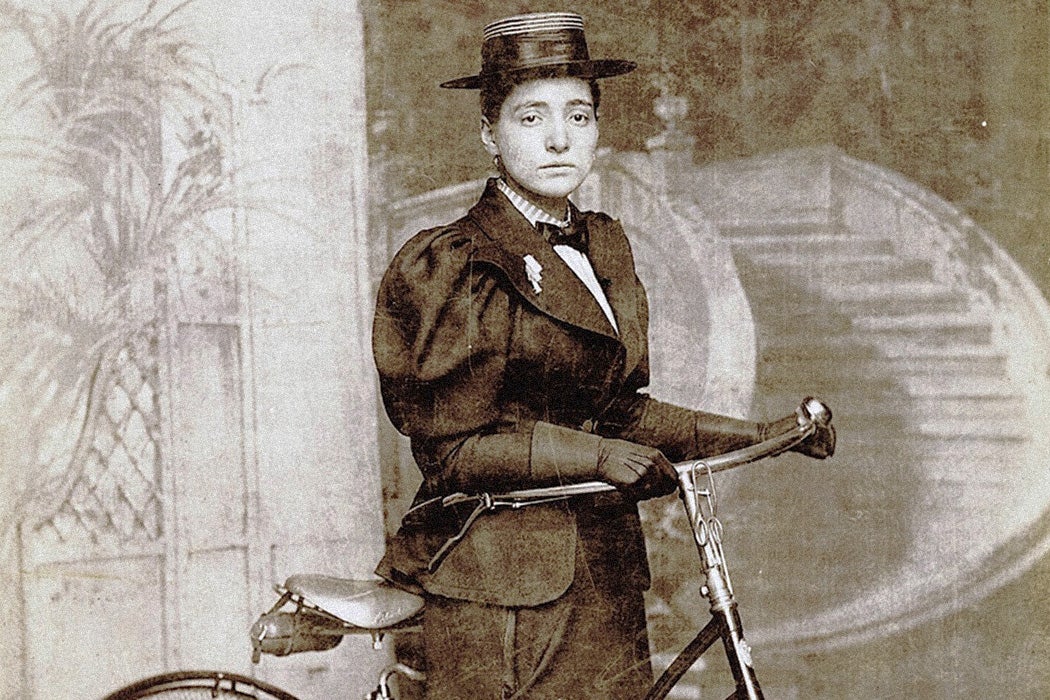Imagine you’ve just finished a fifteen-month bike tour. You’ve gone all around the world on two wheels, becoming the first woman to do so and thus earning yourself $10,000 in the process. You heard criticism—it was the 1890s, after all. Biking in pants, leaving your children behind, becoming a loud and assured self-promoter—you’re not exactly the model of womanhood. You even changed your name for promotional purposes, transforming from Annie Cohen Kopchovsky to Annie Londonderry. Cycling under your new surname was part of a deal with one of your sponsors, the Londonderry Lithia Spring Water Company, and you couldn’t pass it up.
And if all that wasn’t enough, you’d sign up for one more big adventure. After coming home from your global tour, you, Annie “Londonderry” Kopchovsky, would be instrumental in capturing the Massachusetts “Wild Man.”
Well, maybe.
In the summer of 1895, Charley Richardson, a farmer from Royalston, Massachusetts, was thrown off of his wagon. As journalist Peter Zheutlin explains, Richardson claimed that the wheel nuts had been tampered with, and he’d later found them in his barn “with a note warning him not to try to find out who had done the deed.” Later, Richardson discovered that someone had killed one of his sheep. And soon after, someone threw a clock pendulum through his bedroom window. The very next day, one of his cows went missing, and fear be damned, he decided he going to get to the bottom of the threats. Armed with “a pistol and five cartridges” he headed into the nearby woods to find his livestock.
As Richardson told the story afterward, he encountered a man in the clearing sitting by a fire. He tried to approach quietly but was spotted. Richardson described the man as thin, gaunt even, “with a scraggly gray beard that stretched to his waist, sunken cheeks, and eyes that ‘blazed fiercely.’” The man, now known as the “Wild Man,” fired his own gun, a bullet piercing Richardson’s coat. Fearing for his safety, Richardson left town for a while. When he returned, he found that the “Wild Man” was at it again. First there was an explosion, and a few days later, someone shot at Richardson again. Who was this mysterious attacker, and who would bring him to justice?
Fortunately, in nearby Boston, a young woman was signing a hotel register. She’d identified herself as “Nellie Bly,” a familiar name to newspaper readers of the time. Bly, Zheutlin writes, “was an investigative journalist with a flair for writing sensational feature stories.” If anyone was going to get to the bottom of all the hijinks in Royalston, it would be Bly.
But this wasn’t Bly, who’d retired from journalism in early 1895.
This was Annie Kopchovsky, six weeks after her round-the-world bike trip had ended and ready for more adventure. When she’d gone on her bicycling tour, she’d filed dispatches for the New York World under the name Nelly Bly, Jr. Now home, she was writing for the paper, and she was in Boston to “capture the desperado.”
The story of the capture of the so-called desperado would later appear in the World, taking almost a full page. Kopchovsky interviewed Richardson, finding him “nothing but a timid boy,” and concluded that the “Wild Man” was just a fantasy: “I soon deduced the theory that Charles Richardson was the wild man who had been shooting at and attacking himself.” Richardson later confessed. “Kopchovsky, alias Nellie Bly Jr., alias Annie Londonderry, had pulled the mask of the vicious wild man, revealing the scared young man underneath,” Zheutlin writes.
Weekly Newsletter
But further examination found some holes in Annie’s story, too. Was Richardson really the “Wild Man”? Had Annie cracked a case—in about a day—that had eluded local law enforcement for months? As Zheutlin notes, she often stretched the truth in her writing, especially during her bike trip, when “she told many tall tales—she was flamboyant and dramatic and eager to spin a good yarn.”
Despite being labeled as a fraud by other newspapers, Annie’s story was typical of the era’s journalism. Her life as a journalist was a lot like her life as an adventurer, Zheutlin explains: “She was, as her bicycle trip demonstrated, fiercely independent, flamboyant, and a risk taker.”







